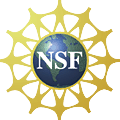
 |
NATIONAL
SCIENCE FOUNDATION
|
World Ocean Circulation Experiment |
|
NSF, NASA, NOAA, the Office of Naval Research (ONR), and DOE are supporting
U.S. participation in the World Ocean Circulation Experiment (WOCE), a
key element of the U.S. effort in global change research and the World
Climate Research Programme. The goals of WOCE are to understand the general
circulation of the ocean well enough to be able to model its present state
and to predict its evolution in relation to long-term changes in the atmosphere.
Global climate system models will require such an oceanographic component.
DescriptionThe U.S. contribution to WOCE consists of activities coordinated by the Science Steering Committee (SSC). Program: Analysis, Interpretation, Modeling, and Synthesis Activities (AIMS) Studies to be supported under the AIMS program announcement may include the analysis and interpretation of WOCE data (with or without other contemporary data sets), the assimilation of WOCE data into ocean or coupled ocean/atmosphere models, comparison of the data with model products, continuation of WOCE modeling and data assimilation activities, and production of data compilations, climatologies and atlases. It is understood that the basic analysis and interpretation of individual data sets and model results will continue, and it is also expected that these will be completed, and the data made public and generally available to the community within two years of the measurements. Beyond that, it is important to continue the task of combining results on a basin- (e.g., North Pacific, Indian Ocean, South Atlantic, etc.) or global-scale, with the latter in particular to be encouraged. These activities may be enhanced by the wider availability of data products derived from WOCE and WOCE-related programs. Projects involving the production and distribution of these data products (as envisioned in the concept of WOCE special analysis centers) are needed to support a wider range of modeling and analysis efforts. Comparison of these results with those of other large programs carried out contemporaneously or in previous years may also be considered.Questions regarding components of the U.S. WOCE program should be addressed to Dr. Piers Chapman, Director, U.S. WOCE Office, 305 Arguello Drive, College Station, TX, 77843 (e-mail: chapman@ocean.tamu.edu). All related documents can be obtained from this office. Related LinksThis web site provides some information about the present U.S. WOCE work, the results being accomplished, and other related resources. Annual Reports of the U.S. WOCE Office for 1995 through 1998. Names and contact information of the Federal Interagency Panel. CLIVAR (Climate Variability and Predictability) is an interdisciplinary research effort within the World Climate Research Programme (WCRP) focussing on the variability and predictability of the slowly varying components of the climate system. CLIVAR investigates the physical and dynamical processes in the climate system that occur on seasonal, interannual, decadal and centennial time-scales.
|
|